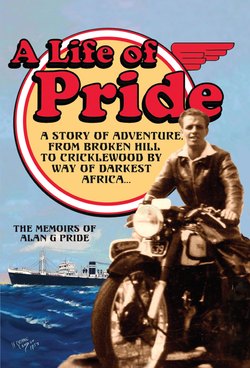Читать книгу A Life of Pride - Alan G Pride - Страница 16
На сайте Литреса книга снята с продажи.
Chapter 9
Quinyambie Station
ОглавлениеOne memorable part of my apprenticeship was a trip into the desert. I was sent with the Zinc Corporation’s head mechanic, Basil Buddle, out into the desert. We were to go up to north-west NSW, past the isolated towns of Tibooburra and Innaminka, into South Australia and the sheep station, ‘Quinyambie’*. It had been owned by Sidney Kidman, Australia’s ‘Cattle King’. The Zinc Corporation’s associate company, CRA, was the exploring arm of BHP, looking for gas, iron ore and minerals. They ran the big six-wheeled trucks called AEC Matadors, which had sensitive differentials in the gearboxes, and one of these had stripped its differential. So Basil was to go up with a replacement and I was to go with him. Why me? I wondered, as we set off in a lovely U.S. Chrysler Airflow car with a beautiful aerodynamic body, almost as fancy as a Cadillac or Packard.
Perhaps I was just along for conversation – but no! When we got north of Yanco Glen, the land rose up in sandhills, steeper and steeper, drifting over the dirt road. Some of them were nearly a kilometre long. Soon we were bogged! Baz opened the boot: in there he had two huge rolls of rubber-backed carpet. And my job was to dig the sand out from under the back wheels and put the carpet down for the car to run on. I must have done this two dozen times during the day. And when we got to the gates between properties, I had to get out to open and close them.
It was late when we got to the station. I was exhausted. The station family, about nine of them, gave us a warm welcome and a huge dinner. Remote stations like this were so isolated, they loved visitors. They’d see Aboriginal boundary riders and sometimes shearers, but rarely people from town. I was impressed by the place the next day. It had its own gardener tending a big garden, kept green with bore or tank water. The vegetables were all wire-netted against the birds, rabbits and ‘roos. The station people killed their own meat too, keeping it in a ‘meat room’ shaded by a big tree next to the homestead. There were no fridges out there (in 1945-46), so the joints of meat lay on long tables between layers of salt. Saturated towels were hung up to try and cool the air.
The actual mining camp was a further 20k's away. Baz and I drove out in blistering heat. There was the big drill bringing test ores up, mullock heaps and workers in tents. We spent two days fixing the broken truck, our only shade the vehicle itself. Then it was thankfully back to Broken Hill, struggling over those sandhills again, while I wielded the shovel and rolls of carpet.
My holidays on the coast had shown me what a remote place Broken Hill was; Quinyambie Station gave me a whole new definition of remoteness! It was fascinating, but I’d never want to live in such an isolated place.
[*Marilyn writes: 'Dad referred to the station as 'Quinnaby'. Research turns up no station of that name, while Quinyambie fits the distance and location described.']
